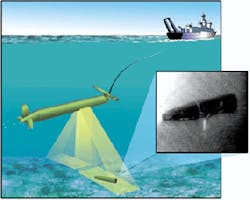Soon after Swissair Flight 111 plunged into the Atlantic Ocean off the coast of Nova Scotia in September, Canadian and US Navy and Coast Guard ships converged on the crash scene. They sent divers and deployed sonar systems to find the broken body of the plane, searching for clues as to what brought down the aircraft and killed all 229 people aboard. One vessel, the Canadian Coast Guard Ship Hudson, brought with it an experimental laser imaging system.
The Electro-Optic Identification (EOID) sensor—being developed for the US Navy by the Office of Naval Research (Arlington, VA)—incorporates a laser linescan system. A ship tows the sensor underwater and gets sharp, real-time images of what lies on the ocean floor. The system provides searchers with high-resolution images of shapes that had been picked up previously by sonar, enabling them to decide whether the shapes were parts of the aircraft that divers had to be sent after or just rocks or old ship anchors.
The EOID sensor includes a 500-mW, frequency-doubled Nd:YAG laser emitting at 532 nm. It has a 70 field of view with a pixel resolution of 0.25 × 0.25 in. or finer when being towed at four knots or less, although pixel resolution is a function of how far the sensor is from the target. The minimum useful distance is about 10 ft. How far it can see depends on the optical qualities of the water in which the system is operating. The device can see at up to five to seven optical attenuation lengths, which translates to about 100 ft from the bottom of the ocean, depending on how much material is in the water column, said Steven G. Ackleson, manager of the Environmental Optics Program at the Office of Naval Research.
The system is based on synchronous scanning, which overcomes the major problem with optical imaging underwater—backscatter from the numerous particles of organic matter and sand in the water. To overcome this, the laser line scanner reduces the field being illuminated to a very narrow column. A multifaceted mirror rotating on a camshaft scans the beam over the seabed to produce a two-dimensional image. Another mirror, offset from the first, scans the reflected beam into a photomultiplier tube. The system also solves the problem of forward scatter, which blurs the image.
In the Swissair case, crash investigators had an idea of where to look from the airplane`s flight path. Sonar readings gave them a rough map of the debris field. The EOID could not be towed over much of the field, in part because buoys had been placed with cables to mark certain parts of the plane. But by towing the device through areas around the edge of the field, the searchers were able to determine that most of the sonar hits were not pieces of the aircraft. That saved the overtaxed divers the trouble and danger of looking in that area and helped define the limits of where the debris spread. The sensor was used only at night, both to avoid divers and because ambient light in shallow water interferes with the imaging. Ackleson hopes to resolve that problem within a couple of years.
An older version of the laser linescan system was used in 1996 to investigate the crash of TWA Flight 800 off the coast of Long Island, NY. Bryan Coles, now manager of underwater electro-optic systems development for Raytheon Systems Co. (Arlington, VA), designed the original prototype when he owned his own company, Spectrum Engineering (San Diego, CA). Raytheon built the EOID for the Office of Naval Research in 1995.
Coles said the earliest system, in 1990, was based on an argon-ion laser and an 8-bit/pixel video frame grabber. The EOID uses a 14-bit analog-to-digital converter, does a small amount of computer processing on the data, and displays an image on a monitor for the operator to work with. The system also records the unprocessed digital data, which can be processed later in a variety of ways. For instance, images can be strung together to make a strip of video. Or topographic images developed from acoustic data, collected by sonar, can be overlaid on the laser data to give three-dimensional images.
The Navy is interested in the system for finding underwater mines and characterizing the ocean floor in areas where it wants to land amphibious vehicles. Ackleson said the Navy will probably buy such a system in about two years.
Other applications
Once the systems get small and inexpensive enough, they can be put into remotely operated vehicles or even into hand-held systems for divers, Coles predicts. "We`re not making the oceans transparent or anything like that," Coles said. But the system does get better resolution than sonar imaging and is better at finding things that divers or video cameras might miss. "These laser systems fit a nice niche between acoustic systems and conventional imaging systems," he said.
About the Author
Neil Savage
Associate Editor
Neil Savage was an associate editor for Laser Focus World from 1998 through 2000.
